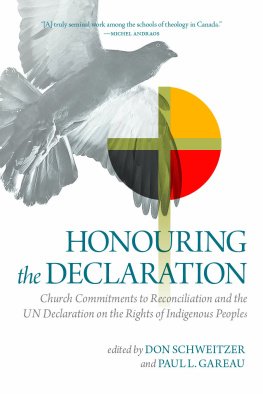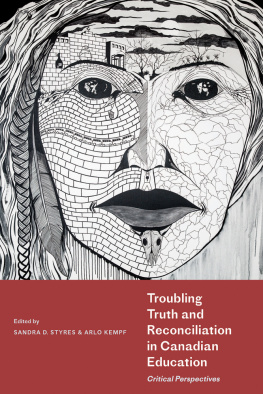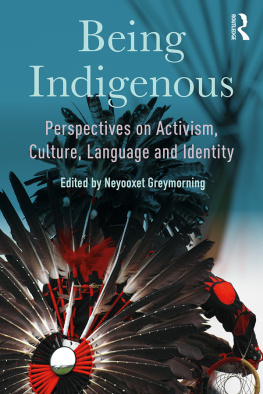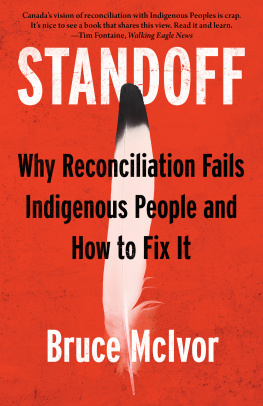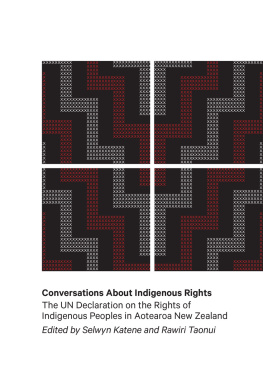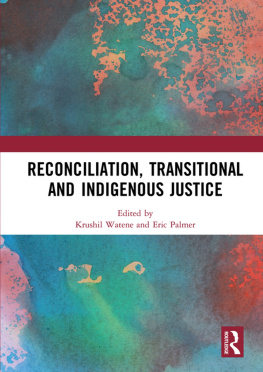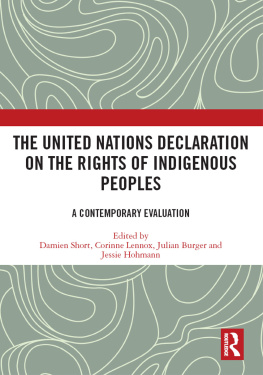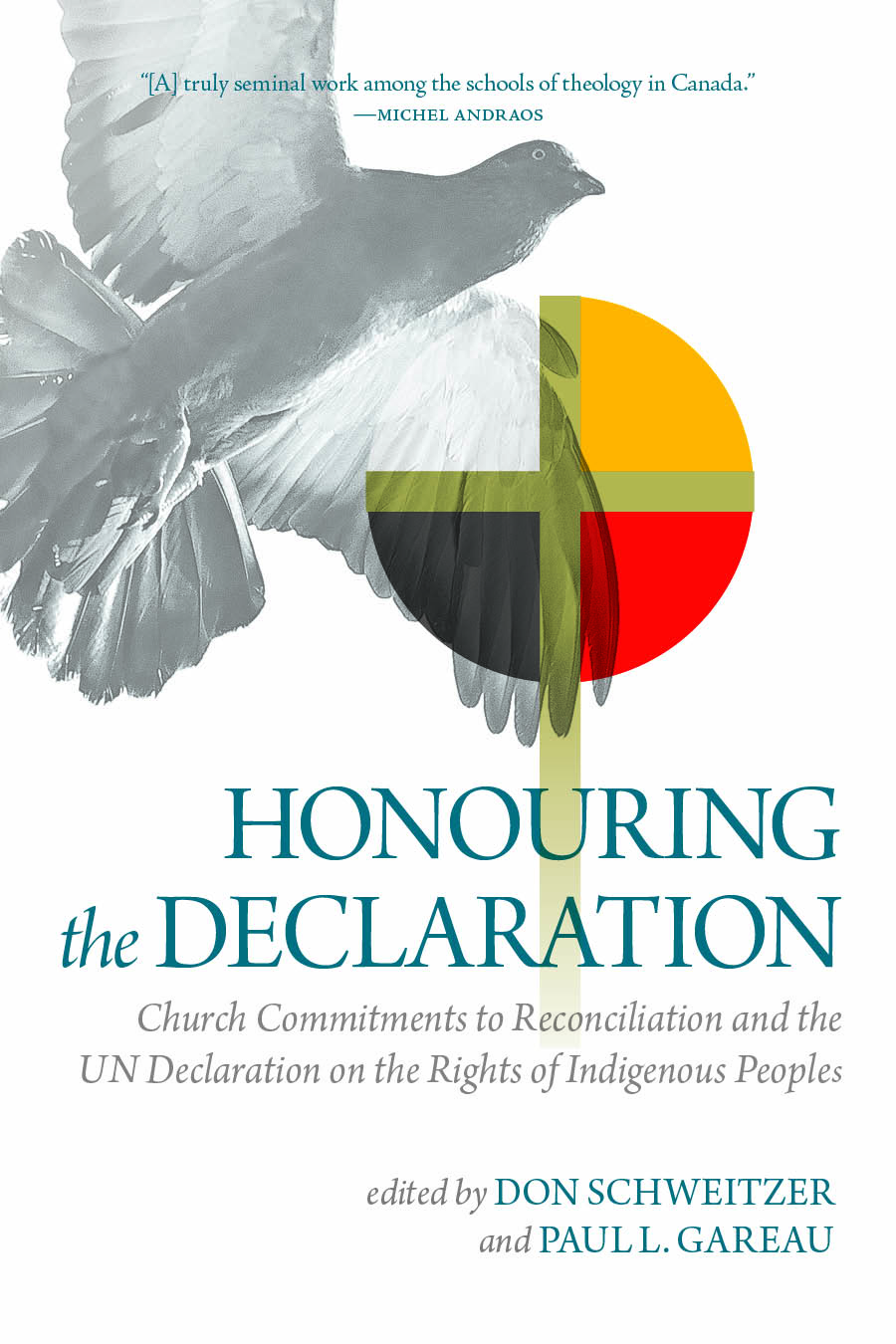honouring the declaration

University of Regina Press designates one title each year that best exemplifies the guiding editorial and manuscript production principles of long-time senior editor Donna Grant.
Honouring the Declaration
Church Commitments to Reconciliation and the United Nations Declaration on the Rights of Indigenous Peoples
edited by
don schweitzer and paul l. gareau

2021 University of Regina Press
All rights reserved. No part of this work covered by the copyrights hereon may be reproduced or used in any form or by any meansgraphic, electronic, or mechanicalwithout the prior written permission of the publisher. Any request for photocopying, recording, taping, or placement in information storage and retrieval systems of any sort shall be directed in writing to Access Copyright.
Printed and bound in Canada at Imprimerie Gauvin. The text of this book is printed on 100% post-consumer recycled paper with earth-friendly vegetable-based inks.
Cover art: Rock Dove ( Columba livia ) with wings raised in flight, in monochrome by Panu Ruangjan / iStock
Cover design: Duncan Campbell, University of Regina Press
Interior layout design: John van der Woude, jvdw Designs
Copy editor: Ryan Perks
Proofreader: Alison Strobel
Indexer: Patricia Furdek
Library and Archives Canada Cataloguing in Publication
Title: Honouring the Declaration : church commitments to reconciliation and the United Nations Declaration on the Rights of Indigenous Peoples / edited by Dr. Don Schweitzer and Dr. Paul L.Gareau.
Names: Schweitzer, Don, 1958 - editor. | Gareau, Paul L., editor.
Description: Includes bibliographical references.
Identifiers: Canadiana (print) 20210232897 | Canadiana (ebook) 20210236779 | isbn 9780889778337 (hardcover) | isbn 978088 9778320 (softcover) | isbn 978088977834 ( pdf ) | isbn 9780889778351 ( epub )
Subjects: lcsh : ReconciliationReligious aspectsUnited Church of Canada. | lcsh : United Nations. General Assembly. Declaration on the Rights of Indigenous Peoples. | lcsh : Civil rightsReligious aspectsChristianity. | lcsh : Race relationsReligious aspectsUnited Church of Canada. | lcsh : Indigenous peoplesCivil rightsCanada. | lcsh : Indigenous peoplesLegal status, laws, etc.Canada. | lcsh : DecolonizationCanada.
Classification: lcc bt .. h 2021 | ddc .dc
10 9 8 7 6 5 4 3 2 1

University of Regina Press, University of Regina
Regina, Saskatchewan, Canada, s s a
tel: (306) 585-4758 fax: (306) 585-4699
web: www.uofrpress.ca
We acknowledge the support of the Canada Council for the Arts for our publishing program.
We acknowledge the financial support of the Government of Canada. / Nous reconnaissons lappui financier du gouvernement du Canada. This publication was made possible with support from Creative Saskatchewans Book Publishing Production Grant Program.

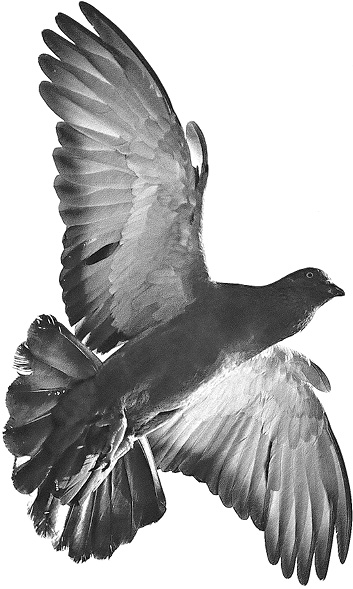
Contents
by D on Schweitzer and Paul L. Gareau
by Sandra Beardsall, Sakej Henderson, and Don Schweitzer
CHAPTER
by Sakej Henderson
CHAPTER
by Christine Mitchell
CHAPTER
by Lynn Caldwell
CHAPTER
by Adrian Jacobs, Keeper of the Circle, Sandy-Saulteaux Spiritual Centre
CHAPTER
by Sandra Beardsall
CHAPTER
by Paul L. Gareau
CHAPTER
by HyeRan Kim-Cragg
CHAPTER
by Don Schweitzer
CHAPTER
by Jennifer Janzen-Ball
CHAPTER
by Iskwewuk E-wichiwitochik/Women Walking Together
by Sakej Henderson and Don Schweitzer
Appendix A:
Appendix B:
Acronyms
ancc: All Native Circle Conference
crgb Models: Culturally Relevant Gender Based Models of Reconciliation
djsrc : Doctor Jessie Saulteaux Resource Centre
dmc : Division of Mission in Canada
fstc: Francis Sandy Theological Centre
gce: General Council Executive
ibnwt: Indian Brotherhood of the Northwest Territories
icpond: Interchurch Project on Northern Development (Project North)
ie: Iskwewuk E-wichiwitochik/Women Walking Together
mmiwg s: missing and murdered Indigenous women, girls, and Two-Spirits
ncc: Northern Coordinating Committee
nib : National Indian Brotherhood
nimmiwg s : National Inquiry into Missing and Murdered Indigenous Women, Girls, and Two-Spirits
nwac : Native Womens Association of Canada
sps : Saskatoon Police Service
sssc : Sandy-Saulteaux Spiritual Centre
trc : Truth and Reconciliation Commission of Canada
ucc : The United Church of Canada
undrip : United Nations Declaration on the Rights of Indigenous Peoples
Foreword
On November and , 2017 , the contributors to this volume gathered at St. Andrews College in Saskatoon, located on Treaty territory and on the Mtis Homeland. We congregated to present and discuss the outlines of our chapters and talk about the possibility of bringing them together into an edited collection. This meeting decisively shaped what you are now reading in several ways. We must first explain some of the terms and ideas from this book.
First Sakej Henderson, who spent years working along with others to draft what became the United Nations Declaration on the Rights of Indigenous Peoples, expressed an aversion to the acronym undrip . Out of respect for him, in what follows we have used the Declaration as an abbreviation for this document instead, although undrip does appear in quotations and references. Second, our authors use the term Indigenous to speak generally of the perspectives and experiences of the First Peoples of the land on which we live and where this book took shape. This term does not negate the importance of recognizing the term Aboriginal, which in section of the Constitution Act, 1982 recognizes Treaty Rights of First Nations, Inuit, and Mtis Peoples living in Canada. Our orientation is always toward Indigenous self-determination by naming Indigenous nations in our texts using Indigenous autonyms and languages where we can. In this way, we affirm Indigenous sovereignty in our writing by reflecting the experiences of Indigenous Peoples in place, as was well as in relations with other peoples and in other places.
Finally, the group did not want to have one or two editors making autocratic decisions about other peoples chapters. So instead of having editors, two timekeepers were chosen, who were charged with keeping the project moving ahead. However, as these timekeepers, we found that some aspects of the work of making a collaborative, edited volume were unavoidable, and that timekeeper is not yet a recognized term in academic publishing. So, in a concession to convention, we are listed as editors in the books front matter. However, in editing this book, we strove to adopt a deeply collaborative approach. Over the time of writing, authors were set into pairs to review and support each others work. It was a helpful and relational way to find the critical voice of our chapters as well as to help one another in the collaborative editing process. Major editorial decisions such as chapter order were made by the group, and in that regard our role has indeed been more of timekeeping than a strictly top-down, editorial one. It has been an honour to have been entrusted with this responsibility.

